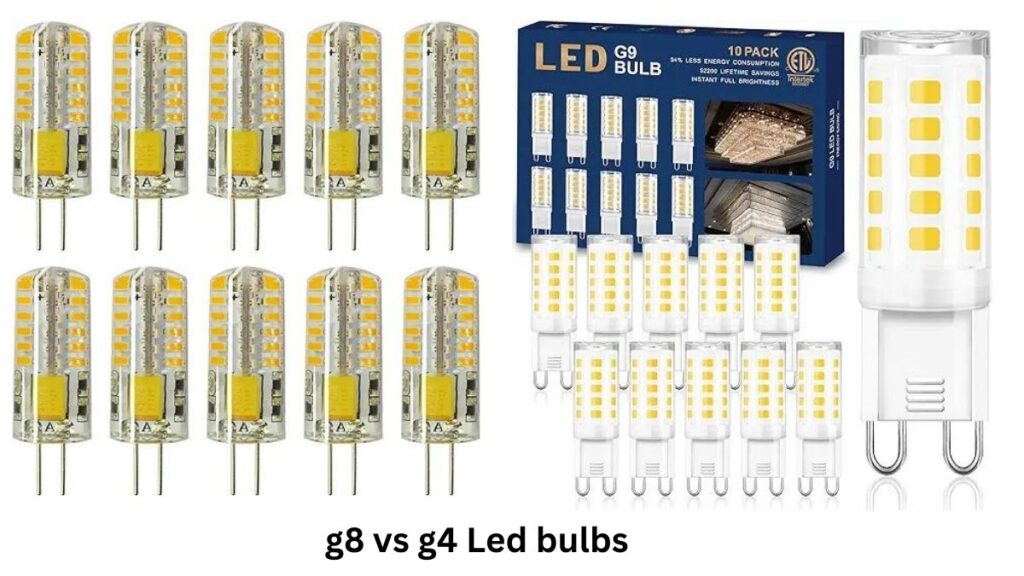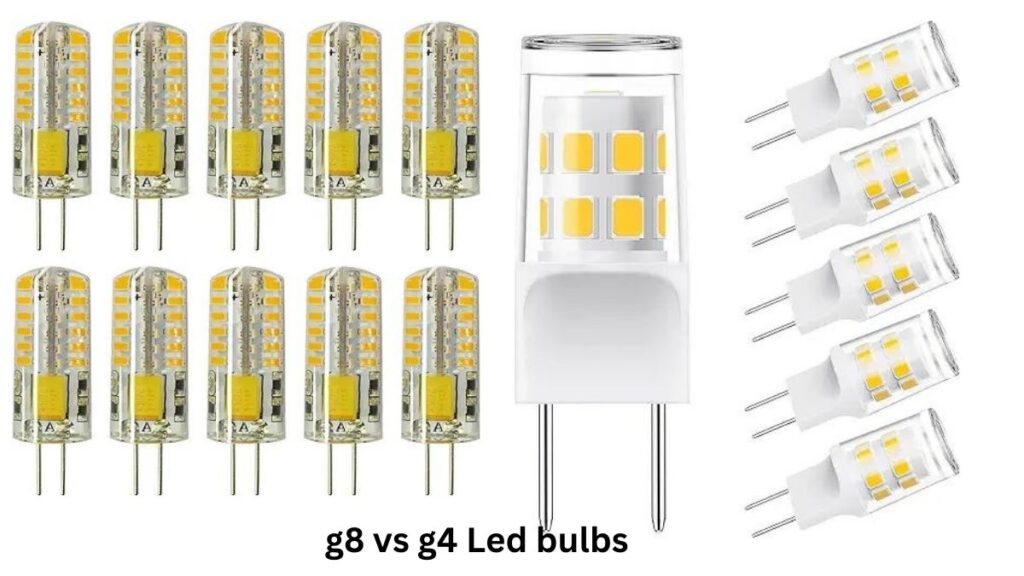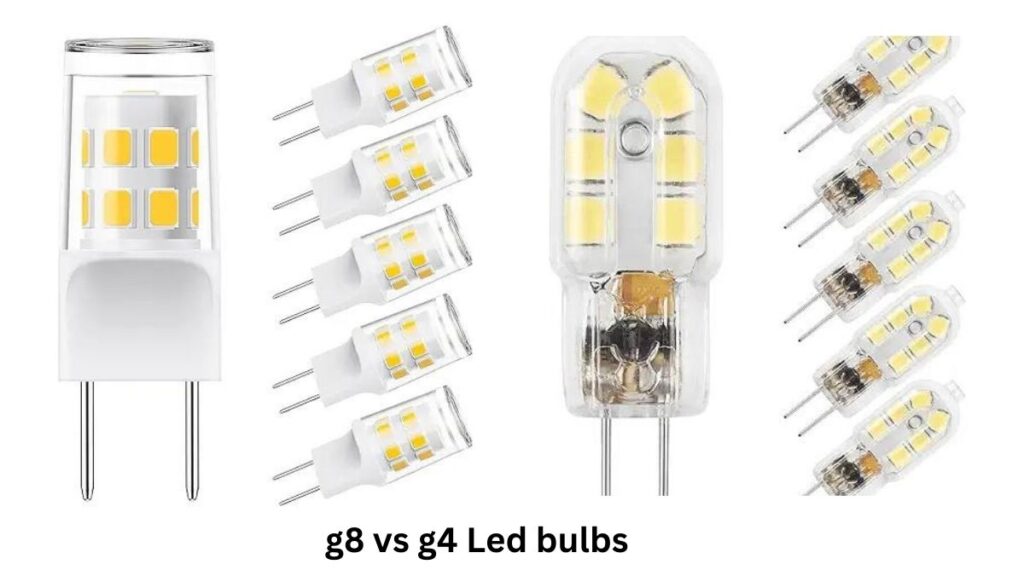When choosing between G8 vs G4 bulbs, it’s easy to get confused by their similar-sounding names. However, these two types of bulbs are quite different in terms of application, power, and efficiency. Knowing the difference can help you pick the right bulb for your home or office lighting setup, whether you’re looking to brighten up a room or add a bit of ambiance.

What Is a G8 Bulb?
Let’s start by understanding the G8 bulb. The name “G8” refers to the base type of the bulb, with the number “8” indicating the distance between the two pins, which is 8mm. These bulbs are commonly used in kitchen lighting, under-cabinet lights, and sometimes in pendant fixtures. You’ve probably seen them in workspaces or countertops where focused light is essential.
Key Features of G8 Bulbs:
- Pin spacing: 8mm between pins.
- Common voltage: Often 120V or higher.
- Application: Ideal for task lighting, like under-cabinet lighting or kitchen fixtures.
- Wattage: Typically comes in higher wattages for bright illumination.What makes the G8 bulb stand out is its ability to produce a higher amount of light, which is perfect for spaces where you need more visibility. It’s practical for rooms where you spend a lot of time working, like the kitchen or garage.
Pros of G8 Bulbs:
1. Bright and Focused Lighting: They provide a significant amount of light, making them great for workspaces.
2. High Voltage: Most G8 bulbs operate at 120V, which means they can be plugged directly into your home’s electrical system without needing a transformer.
3. Versatile Applications: Ideal for kitchens, workspaces, and pendant fixtures.
Cons of G8 Bulbs:
1. Higher Energy Usage: Traditional G8 bulbs can consume more electricity if not replaced with LEDs.
2. Heat Emission: Older G8 halogen bulbs can get hot, which might not be ideal for enclosed spaces.
What Is a G4 Bulb?
Now, let’s move on to the G4 bulb. The name “G4” refers to its base type, and the number 4 indicates a pin spacing of 4mm. G4 bulbs are smaller and more compact compared to G8 bulbs, which makes them perfect for decorative fixtures, chandeliers, or small desk lamps. These bulbs are often used in accent lighting where you want soft, ambient light rather than bright, direct light.
Key Features of G4 Bulbs:
- Pin spacing: 4mm between pins.
- Common voltage: Usually operates at 12V or 24V, which means they need a transformer.
- Application: Great for ambient or accent lighting in chandeliers, small lamps, and landscape lights.
- Wattage: Generally lower wattage compared to G8 bulbs, making them more energy-efficient in small settings.

Pros of G4 Bulbs:
1. Compact Size: Ideal for small, decorative light fixtures.
2. Energy Efficient: Low wattage means they consume less energy, especially when paired with LED technology.
3. Cooler Operation: G4 LED bulbs emit less heat, making them safer for enclosed or tight spaces.
Cons of G4 Bulbs:
1. Lower Brightness: They don’t produce as much light as G8 bulbs, so they’re not suitable for task lighting.
2. Requires Transformer: G4 bulbs usually need a transformer because they run on low voltage.
G8 vs G4 Bulb: Comparing the Differences
Now that we’ve covered the basics, let’s dive into a detailed comparison between G8 and G4 bulbs. Here’s a breakdown of the key differences to help you choose the right one for your lighting needs.
1. Pin Size and Base Type
- G8 Bulb: The G8 bulb has a larger base with 8mm spacing between the two pins.
- G4 Bulb: The G4 bulb has a smaller base with only 4mm between the pins.
If your light fixture requires a specific pin size, you’ll need to ensure you’re using the correct one. Double-check your fixture’s compatibility before making a purchase.
2. Voltage
- G8 Bulb: Most G8 bulbs are designed to operate at 120V or 240V, which means they can be directly connected to standard home wiring without a transformer.
- G4 Bulb: G4 bulbs, on the other hand, usually operate on 12V or 24V, requiring a transformer to step down the voltage. This can add complexity to your lighting setup.
If you’re looking for a simple plug-and-play solution, G8 bulbs are often more straightforward to install.
3. Brightness and Application
- G8 Bulb: Offers bright and focused lighting, making it ideal for task lighting, such as in kitchens or workspaces.
- G4 Bulb: Provides soft, ambient lighting, perfect for accent lighting in chandeliers or decorative fixtures.
Your decision between G8 vs G4 will depend heavily on where you’re planning to use the bulbs. If you need a bulb for detailed tasks, go for G8. But if you’re looking to create a cozy, atmospheric feel, G4 is the better option.
4. Energy Efficiency
Both G8 vs G4 bulbs are available in LED versions, which are much more energy-efficient than their halogen counterparts. However, G4 bulbs tend to consume less power overall, given their lower wattage and smaller size.
- G8 LED Bulbs: These offer high brightness while consuming less power than traditional G8 halogen bulbs. They’re great if you need strong illumination without the high energy costs.
- G4 LED Bulbs: G4 LEDs are incredibly efficient for decorative and accent lighting. They use very little power while still providing soft light for small fixtures.
5. Lifespan
When it comes to longevity, LED bulbs outshine halogen bulbs by a long shot. Both G8 and G4 LED bulbs can last between 15,000 to 30,000 hours, depending on usage and brand quality. Investing in LEDs might be more expensive upfront, but the long-term savings on energy bills and bulb replacements are worth it.
6. Heat Emission
- G8 Bulb: Higher-wattage G8 bulbs can emit more heat, especially if they are halogen. If you’re using them in an enclosed space, you might need to monitor the heat levels.
- G4 Bulb: G4 bulbs, particularly LED versions, emit minimal heat, making them safer for enclosed fixtures.

Which One Should You Choose?
Now that we’ve covered the technical aspects, how do you decide which one is right for you?
- Choose G8 Bulbs: If you need bright, direct lighting for tasks or workspaces like kitchens or countertops. They are also better for fixtures that need 120V power.
- Choose G4 Bulbs: If you want soft, decorative lighting for smaller fixtures or accent areas like chandeliers or desk lamps. They work well in spaces where you don’t need intense brightness but want to create ambiance.
Conclusion
Both G8 vs G4 bulbs have their unique advantages and are designed for specific lighting purposes. Whether you’re upgrading your kitchen lighting or adding a soft glow to your living room, understanding the differences will help you make the best choice.
With this detailed guide, you now have the information you need to confidently select between G8 vs G4 bulbs, ensuring you find the perfect fit for your home or office. Happy lighting!
Related articles:
Hi, I’m Malik Suhail—an SEO expert, web designer, and passionate blogger with 2 years of experience. I specialize in crafting content that is not only informative but also tailored to meet the needs of my readers.
I write about diverse topics, always striving to simplify complex ideas and provide valuable insights that resonate with my audience. Whether it’s about SEO strategies, web design trends, or blogging tips, I am committed to delivering well-researched, practical, and easy-to-understand information.
My mission is to help readers navigate the digital world with confidence and clarity. I believe in adding value through authentic content that inspires action and delivers results.


